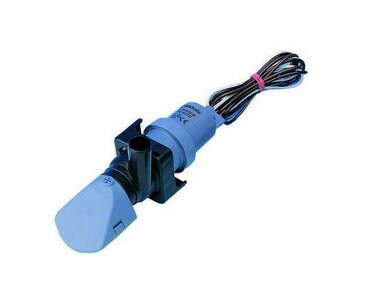Bilge Pump Experiments.
I preformed all of the following tests in my bathtub. I did not test the pumps flow rates, as there are numerous sources online detailing pumps advertised vs delivered flow. I did however test the pumps for dependability, and and Air Binding. Water levels in the bathtub were maintained flush with the top of the bilge pump; for consistency among the tested pumps.
After many trips to Academy I pretty much tested every bilge they have. I will list them below and my experiences with them.
Rule-Mate 750 and 1100:
Automatic pump with spongability.
Cycle time: According to the MFR this pump is not supposed to turn on until the float switch has been in the up position for 2 full seconds. Findings=false with power to the pump, simply shaking the pump in an upward direction once will turn the pump on. This means in a jet ski, it will basically be running the entire time as the ski bounces up and down often.
: Supposedly the pump will run for 15 seconds after the float switch reaches the down position. Findings=true Pump functions according to MFR
: Air Binding: I found that with this pump if the water shifts away from it momentarily that it will begin air binding. How I tested this was to partially lift the pump from the water with it running. Once the pump lost its prime it failed to regain it prime until the power was cycled. Finding=unacceptable. With an automatic pump you cannot cycle the battery. In a Jet Ski one can expect the water to shift and slosh often cause a pump to lose its prime, whilst not staying dry long enough for the dry sensor to cycle power.
Summery: The Rule-mate 750 will cycle from the bounce of the Jet Ski, it will Air Bind badly. I realize there are people on this forum that swear by the Rule-Mate; but in my tests it would appear this pump would run nearly full time in a ski. If you wish to have a pump running full time, buy a cheaper non automatic one and just use the fuse method. Not a good buy.
Attwood Sahara pumps 500 and 750 automatic:
I could not find a detailed listing of how this pump was designed to function concerning the pump cycle/pump delay.
Cycle: Pump turned on in a similar manner as the Rule-mate. This pump would basically run the entire time as the ski’s bouncing would turn it on.
Air Binding: Same outcome as the Rule-Mates listed above.
Anyone noticing a trend here?
Rule 360:
Air Binding: Pump operated as described by the MFR until the water was shifted away; pump momentarily Air Binded momentarily then continued normal operation.
Summery: Although this pump does not move large volumes of water, it is dependable.
Rule 500: pump operated as described by the MFR until the water was shifted away; pump Air binded and sometimes continued normal operation.
Summery: This pump cannot be expected to instantly regain prime after an Air bind, this knowledge should be considered after a sub or fountain.
Rule 800: Pump operated as described by the MFR until the water was shifted away; Pump Air Binded and failed to regain its prime until the power had been cycled.
Summery: This pump really moves some water, but I would recommend cycling the switch any time you feel it may have Air Binded.
Attwood Tsunami 500 and 800: Both of these pumps operated normally until the water was shifted away. The 500 sometimes regained its prime without cycling the power while the 800 just like the Rule 800failed to regain prime without cycling the power.
Now that I have covered all of the pumps I will touch on come of the other experiments I conducted. I tried multiple tube routing configurations to see if any would solve the air binding problems, Short tube, long tube, tube with a loop in it, high head, and low head.
Short hoses tend to air bind less but having a short hose alone does not guarantee pump operation.
Long hoses appeared to slow the flow rate, but keep in mind I did not measure flow rates.
Hoses with loops did not seem to have much affect at all, until I reached the next experiment.
In my quest to eliminate Air binding on all tested pumps I poked a hole( a little smaller than a pencil seemed to work well) in the bottom of the hose near the bilge pump. While in an Air Bind situation this hole allowed the water to drain from the hose until the head was small enough for the pump to overcome the Air Bind and continue normal operation. The amount of time it takes each pump to regain prime with this method varied, but all did regain within 30 seconds.
You read that correctly, as others have mentioned on this forum a hole in the base of the tube does allow the pumps to regain prime. Power cycling was not necessary on any of the pumps to overcome Air Bind with the hole. Clearly two problems present them selves with this fix, flow rate is presumably diminished and now any time the exit goes below the water line it is allowed to flow in.
Summery: All centrifugal pumps Air Bind ( except the 350, its to slow anyway) and power cycling is the best method of regaining prime. If power cycling is not an option, poking a hole in the bottom of the hose will allow the pumps to regain prime, but GPH is lost.
I ask that anyone willing to test the GPH lost by poking a hole in the hose please do so and post results here. I did not have a 5 gallon bucked to pump into in order to test GPH.
This post and my tests are meant to be helpful, if you have no constructive advice or criticism take it else where please.


